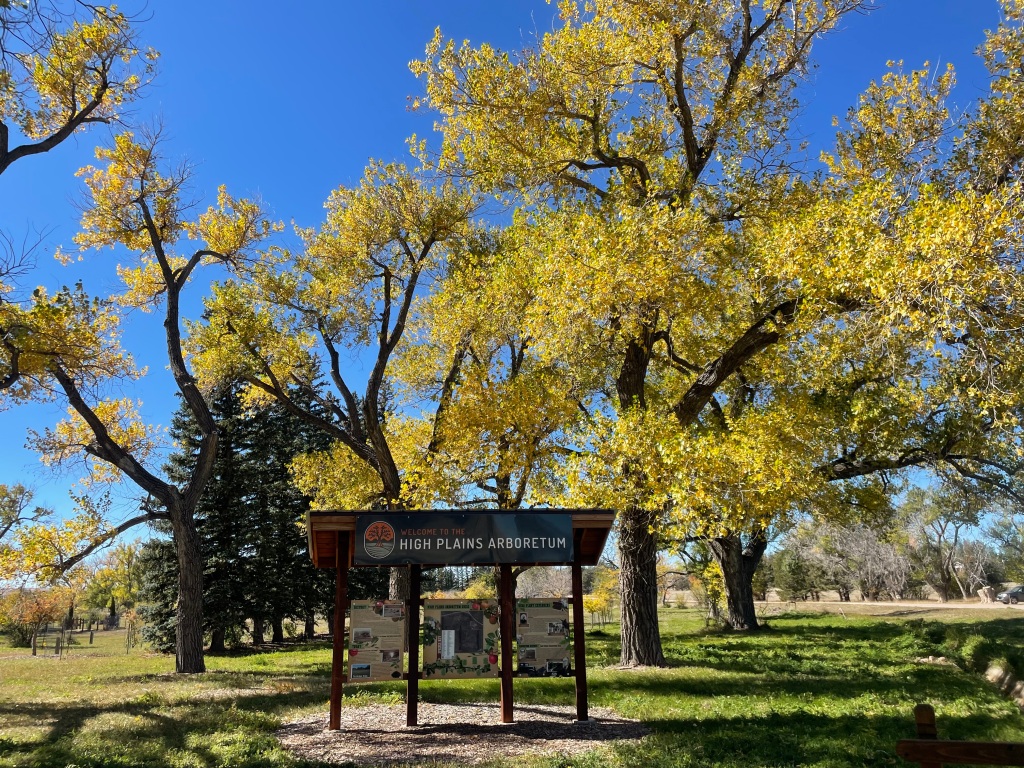
Published Jan. 12, 2024, in the Wyoming Tribune Eagle.
The High Plains Arboretum: A living legacy of horticultural research
By Jessica Friis, guest columnist
For decades after the Homestead Act, many settlers had tried and failed to establish roots in the high plains of Wyoming. The combination of short growing seasons, unpredictable early and late frosts, low precipitation, high winds, and lack of winter snow cover makes it especially hard for trees to survive.
Hoping to help settlers get established and beautify budding communities, the United States Department of Agriculture (USDA) constructed a horticultural field station west of Cheyenne to find or develop plants that could survive the harsh conditions of the high plains.
From 1930-74, station staff tested native plants from around the region, as well as foreign plants collected from similar climates around the world and introduced by USDA plant explorers. If no suitable plants could be found, researchers bred new varieties. They developed varieties of strawberries, raspberries, tomatoes, pumpkins, and ornamental plants specifically for Wyoming’s harsh climate and short growing season.
A class featuring the heirloom vegetable varieties that were tested or developed at the station will be offered at the Cheyenne Botanic Gardens on February 24, and seeds will be available for purchase. Visit www.botanic.org for more information.
Trees and shrubs grown at the station were distributed around the state and region to help landowners establish shelterbelts and beautify the grounds of many government buildings, including the state capitol, University of Wyoming, Colorado State University, the Veterans Administration hospital, highway department, and many more.
The research conducted at the station changed the landscape of the high plains. New varieties released by the station were shared with local nurseries so that homeowners could grow their own produce at a time before refrigerated shipping brought fresh produce to grocery stores.
The Civilian Conservation Corps (CCC) had two camps at the station during the Great Depression. A veterans’ camp assisted with the daily labor needs from 1935-42. A junior camp beautified the area around the Roundtop Water Treatment Plant from 1935-37. Buildings, stone terraces, bridges, and campsites constructed by both CCC camps remain on the station. For more information on the fascinating history of this site, the book “High Plains Arboretum” is available at the Cheyenne Botanic Gardens giftshop or online.
In 1974, the focus of the station was changed to livestock grazing and mining reclamation research. With these changes came a new name, the High Plains Grasslands Research Station. Rangeland research still continues at the station under the USDA’s Agricultural Research Service.
When the focus of the station shifted away from horticulture, most of the horticultural plots were removed. The trees and shrubs in the arboretum were left standing, and members of the staff continued to till the weeds and irrigate during dry spells. Despite these efforts, almost half of the 1,175 trees and shrubs inventoried in 1978 had died by the turn of the century.
In 2000, a group of concerned citizens formed to save the trees remaining in the arboretum. After years of negotiations, 62 acres of land encompassing the arboretum was returned to the City of Cheyenne. The space was named the High Plains Arboretum and opened to the public in 2008. Since that time, the Cheyenne Urban Forestry Division and Cheyenne Botanic Gardens have worked together with limited funding to preserve the remaining plants, replace some of those lost, and provide interpretative signage for visitors.
The City of Cheyenne and other stakeholders are now working with Wyoming State Parks and Cultural Resources to create the High Plains Research Station and Arboretum State Historic Site. The bill to create this historic site will go before the Wyoming State Legislature in February.
The vision is to have the city continue to care for the historic arboretum, while state parks will manage the remaining property. This includes preservation and restoration of historic structures, interpretation of Roundtop and the history of the site, and master planning to ensure all partners can work together seamlessly.
The city of Cheyenne is working to return to the original mission of growing plants best adapted to Wyoming’s climate for statewide use. We hope that by working together, the site can be more accessible to visitors and serve the public as a wonderful historic site.
For more information on this effort, an information session will be held at the Wyoming State Museum on Tuesday, January 16 at 6:30 pm.
Jessica Friis, horticulturist at the Cheyenne Botanic Gardens, and author of the book “High Plains Arboretum”, enjoys beautifying the Paul Smith Children’s Village, researching the High Plains Arboretum and educating the public on growing plants in Wyoming. Contact her at jfriis@cheyennecity.org.
